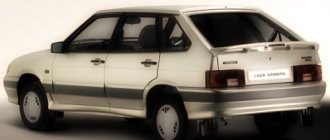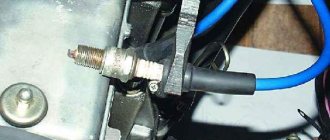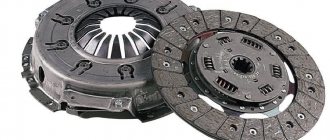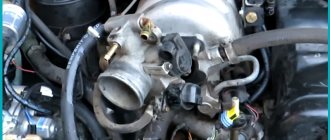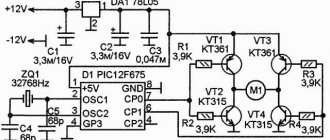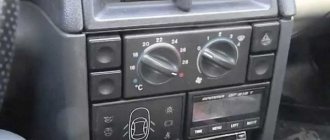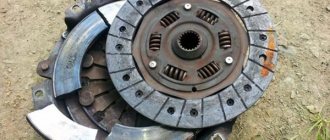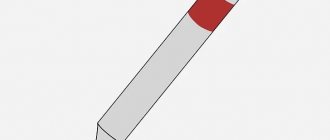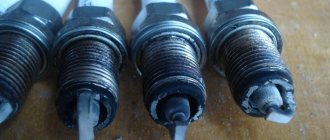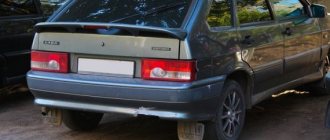March 13, 2015 Lada.Online 59 309 7
A car suspension is a set of parts, assemblies and mechanisms that play the role of a connecting link between the car body and the road. Its design and settings determine how well road unevenness will be smoothed out and how stable the car will be. When developing the Lada Granta/Kalina suspension, AVTOVAZ used a number of unique settings. Have manufacturers managed to create a reliable and ergonomic suspension?
Front suspension "Lada Grants"
It has an independent suspension with wishbones and a stabilizer bar. Damping of vibrations is carried out by hydraulic shock absorbers. The main structural element is the stand. It includes a swivel bearing, shock absorber and spring. The latter uses coils of variable diameter. The spring itself is made of a metal rod with a circular cross-section. It can have variable and constant hardness.
The front suspension of the Lada Granta is designed so that the lower part of the strut rests on the steering knuckle. When the wheels turn, the spring and shock absorber rotate with it. The stand itself remains motionless. Thus, the engineers achieved an increase in the service life of the elastic element while maintaining the inlet hole in the shock absorber body.
The pillar support has also been improved. Suspension creaking on the Lada Granta appears much less frequently than on Kalinas and Priors. To reduce roll, the design includes a stabilizer bar. It is made of spring steel. The stabilizer is installed with its ends to the lower suspension arms. Its middle part is fixed to the body.
Independent suspension type
In this type of suspension, the wheels are not connected to each other , that is, they act independently. Independent suspension has an advantage when driving along the highway at high speed and is usually installed on passenger cars.
The advantages of independent suspension include:
- Small deviations relative to the longitudinal axis.
- Good handling.
- Good grip on the road surface.
- High level of comfort.
The disadvantages of this type of suspension are:
- Expensive maintenance and repairs.
- Short travel of the suspension arms, which can lead to a decrease in ground clearance.
- A large number of parts that make up the suspension and, accordingly, a greater likelihood of damage compared to the dependent one.
- Difficulty in carrying out repair work in the field.
Rear suspension
Unlike the front, it has undergone virtually no changes. Here, just like on the first Soviet G8s, a semi-independent beam is used. It is attached to the body on hinges (fortunately, there are no “crabs” in the design). A helical spring with constant stiffness is used as an elastic element. To dampen vibrations and prevent swinging, two shock absorbers are used.
The elements come from the factory are oil type. The spring is fixed together with the shock absorber. This greatly simplifies maintenance work, but has a negative impact on handling. Often the rear axle skids when cornering. But despite the archaic design, the owners speak positively about this suspension and highlight a number of advantages:
- High reliability. The design does not have additional levers, which, in addition, can bend when falling into a large hole.
- Energy intensity. The Lada Granta absorbs all bumps perfectly, especially if oil shock absorbers are installed at the rear.
- Cheap maintenance. Due to its simple design, this pendant can be rebuilt even with your own hands. And the cost of new rubber-metal elements is unlikely to empty the pockets of even the most stingy car owner.
The main difference between the “Grant” suspension is the wheel alignment angles.
They have a positive camber of about 0.1°). On Priora, for example, this figure is -1 degree. Next, we will consider the main malfunctions of the chassis on the Lada Grant.
What are the similarities and differences between independent and dependent suspensions?
Both of these types of suspensions have one common purpose - to make being in a vehicle more comfortable and safe .
Structurally, independent and dependent suspensions are united by the presence of elastic elements, guide elements and shock absorbers. These functions can be combined in one part, for example a spring.
Due to their different designs, dependent and independent suspensions have a number of differences:
- In a dependent wheel, two wheels are rigidly connected and depend on each other. In independent, everyone acts independently; impact on one will not affect the other.
- In independent there is less unsprung mass, since there is no bridge, as opposed to dependent.
- Independent suspension is sensitive to the installation of wheels of a different size from the required ones, since they are part of the suspension kinematics.
- A necessary condition for the effective operation of an independent suspension is that the kinematic center is above the road surface, in other words, at maximum deviations, the suspension must be above the road level.
- Independent suspension has a lower risk of tipping over when falling into a hole at high speed, due to the absence of rigid interaction between opposite wheels.
The buyer decides which suspension to choose. You should pay attention not only to the level of comfort, but also to the cost of maintenance and spare parts, reviews on the service life of suspension elements and the reputation of the manufacturer.
Shock absorber
This element is a damping device. The shock absorber serves to reduce the range of vibrations of the car body. In other words, the element prevents spontaneous rocking. The work of the shock absorber is based on hydraulic resistance. Inside it there is a liquid of a certain viscosity. It moves through a special valve. Thus, the device absorbs sharp impacts while preserving vulnerable suspension parts. Therefore, the shock absorber is one of the most important components in the chassis. On our roads, this element lasts about 60-80 thousand kilometers. But this period may be shorter, even with careful driving. It is enough just to damage the protective boot, and all the dirt will accumulate in the rod seal.
The rear shock absorbers suffer the most wear because they have much longer stroke. When driving quickly through potholes, the hydraulic fluid may simply boil. This is one of the reasons why a shock absorber fails. But most often it leaks - the valve loses its tightness due to a strong breakdown or impact. As a result, the outer side of the cylinder becomes coated with an oily liquid. How to determine that this element has failed? It’s very simple - you will hear a characteristic knock in the suspension of the Lada Granta. Moreover, it is clearly visible in the cabin. From the outside, you can hardly hear a broken shock absorber. This knock is so strong that even good music cannot interrupt it. You will hear a broken shock absorber immediately.
Also note that the damping element changes in pairs. That is, in the event of a breakdown of the rear left shock absorber, the rear right shock absorber also changes. As for the front struts, they are more durable. Often they are replaced already assembled with a spring, since they fail no earlier than after 150-200 thousand kilometers.
Silent blocks
By 100 thousand, the silent blocks of the cross member and lower arms fail. Signs of a malfunction are a dull knock from the front suspension of the Lada Granta. Motorists recommend replacing these elements with polyurethane ones.
They are characterized by higher strength and good service life. At the factory, rubber silent blocks are installed that do not withstand the impacts of our roads. To replace, we need to press out the old element. First, the bead is cut off from it, and then knocked out using a mandrel or chisel. Pressing is done using a vice. It is important to maintain alignment and not mix up the installation side. For easier pressing, it is recommended to use lubricant.
The silent blocks of the anti-roll bar also fail. These bushings are also replaced with polyurethane ones.
Cause of malfunction
The main cause of element malfunction is a violation of the boot seal. Once it starts to crack, dirt and dust will get inside. They act on the ball like an abrasive. As a result, play appears and the support begins to break on its own. Is it possible to repair it? The Lada Granta suspension is designed in such a way that the ball joints cannot be restored and must be replaced entirely with new ones.
These elements are replaced as a set. The price of two balls is about 700 rubles. The service station will charge about 600 for installation. Although you can replace them yourself. All you need: a jack, a pit, a set of sockets and a special sprocket wrench. But please note that the bolts in this place may become sour. When replacing, there is a high risk of licking off the edges of the sprocket. Unscrew all bolts very carefully - do not press too hard. The service life of original ball joints is about 40 thousand kilometers.
Lada Kalina Universal › Logbook › Suspension Autoproduct CROSS KALINA +15
Actually, it all started with the fact that the left front strut died, completely died. The right one is also not entirely alive.
At the time of replacement, mileage and date:
The choice arose about what to take, for me the main thing was their viability. As a result, the choice fell on racks from an auto product; they have a CROSS series with +15 inflation. Gas oil struts. For me this is a plus, since sometimes I have to drive on very bad roads. They also provide a 2 year warranty. Ordered from local representative. A set of racks plus an installation kit cost 9,720 rubles. I left the old springs.
The kit itself that was taken:
During assembly, I realized that the bumpers that were in the installation kit did not quite fit. As a result, I had to run to the spare parts and get new ones. We took SS20 bumpers and ten-size anthers, which cover completely. As a result, they came out at 940 rubles.
Below are photos of the process and the racks themselves.
In principle, there is nothing difficult about replacement. After installation, I called the Pushka Auto Service Center on Pushkarskaya 55 to find out about the wheel alignment, they started scaring me about the steering ends. And that their revival will cost 2 times more than the collapse itself. Fig im. The next day I took it off, everything came out quite well. We can probably say thank you to those who collected them and lubricated them inside. After which I went to the wheel alignment. There they told me that the balls were dead. And it’s useless to make a collapse with such people. What can I do, they drive the car back, charging me 300 rubles. for the diagnosis (It's a shame, though). Well, what to do, the problem of choosing balls arose, but in order not to have to mess with it again later, I decided to change the ends too. The ball ones cost 800 rubles. Tips 1100. I couldn’t find the ball ones I wanted. So I took what I got, fortunately, if they die quickly, it won’t take long to change it, and there’s no need to do a wheel alignment.
Tips Track, did not photograph.
I changed everything, and again it fell apart. Do it, do it. But the steering wheel still stands a little differently. When driving around the city, not so noticeably, on the highway, the steering wheel seems to be turned a little to the left. I’m still thinking whether to go to them and have them redo it, or try to turn the steering wheel myself.
Since installation, I have driven about 600 km. According to first impressions, they are a little tougher than the ones before. The car became taller, and this became noticeable when we had to crawl through all sorts of grasslands. When changing lanes at speed, I don’t notice much roll. Although I mostly drive 70-90, sometimes up to 170, but this is rare and only when absolutely necessary. It seemed that small irregularities, such as a melted road and a washboard on it, were handled very well. It became more pleasant to crawl through the snow porridge. On the rebound, there are no critical blows, only if the hole is very deep. On the old ones, even when leaving the police station there was a knock.
The only thing is that I still expected them to be a little softer. Well, time will tell about their resource.
And it was worth the money: Set of racks + installation kit - 9,720 rubles. Bumpers + anthers - 940 rub. Ball - 800 rub. Steering tips - 1100 rub.
Source
Wheel bearing
This element serves for uniform rotation of the car wheels. There are 4 such bearings on the Grant. On average, their resource is 100 thousand kilometers. What are the signs of a problem? The main symptom is a characteristic hum when moving. It may get worse as the car turns. The hum can occur on either side of the car, depending on which bearing has fallen apart. The entire assembly is replaced with a new one, and it doesn’t matter whether the Lada Granta’s rear suspension or the front one. It is pressed out using a puller with special paws. Pressing takes place in a vice. It is important to maintain alignment when pressing. If a bearing is installed crookedly, it will be subjected to high loads and may fall apart after just a thousand kilometers.
The main enemy of a bearing is moisture. Therefore, during installation it is so important to ensure the element is sealed. Some manufacturers cover it with a special cap (it is put on the fastening nut), which will prevent salt, water and other reagents from getting inside. But as soon as dust penetrates the bearing, the latter begins to operate outside of its temperature range. As a result, the lubricant is washed away, and the dirt acts as an abrasive. Untimely replacement of this element can provoke a sudden wheel wedge, which is fraught with consequences.
